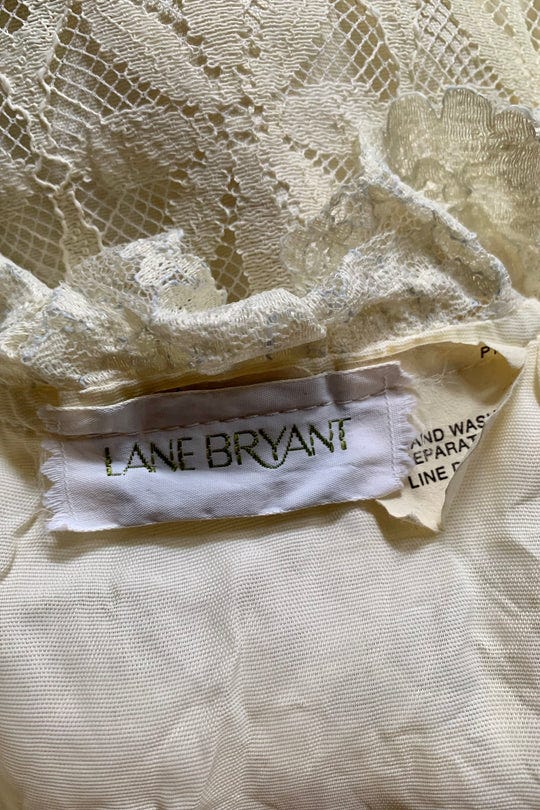Before trying to determine the age of a vintage garment, you have to first figure out whether or not something is vintage in the first place. With all of the references and replicas out there, newer garments can look deceivingly old in both style and construction. You won’t always have the time, desire, or cell signal to do a research deep-dive while you’re shopping secondhand, so it’s good to know what to look out for. While there are some more obvious and well-known indicators, like union labels, other signs are much more subtle. I’ll be sharing four checklists here so that you can easily scan over a garment and put it into a category: either Definitely Not Vintage and Probably Not Vintage, or Probably Is Vintage and Definitely Is Vintage. Once you’ve narrowed it down a bit, you’ll have a better idea of where to go from there.
While the overall quality of garment manufacturing has gone down over the years, even the most fervent vintage collectors know that there are still many brands producing very high quality pieces today. Items that are definitely not vintage might still make sense for your wardrobe and lifestyle. And on the flip side, an item definitely being vintage doesn’t automatically mean it is valuable, well made, or something you’ll actually wear. Vintage vs Not Vintage shouldn’t be the driving force in whether or not you make a purchase, but can be super helpful in determining value, rarity, and to protect yourself from uninformed (or, sadly, scammy) sellers.
Something to keep in mind when dating garments is that, as with most things in life, there are always exceptions! Finding and identifying vintage is like detective work, and it usually requires multiple clues used together to solve the case. While some clues automatically put an item in a category, others should be used in conjunction with each other. Also, this advice is specifically about American vintage! That includes clothing made and imported from overseas, but should be applied to pieces made and sold for the US market.
Definitely Not Vintage
Newly established brands and labels.
While some fast fashion giants like Shein (2008) are obviously new, other brands that may feel very contemporary have actually been around for a long time, like Zara (1963). Also keep in mind that sub-brands and diffusion lines, such as Aerie (2006) or Marc by Marc Jacobs (2001-2015) follow different timelines than their parent labels, American Eagle (1977) and Marc Jacobs (1986). The mass market brands with a long history, such as Abercrombie & Fitch (1892) and Lane Bryant (1904), have a distinctly different look to their labels, branding, and overall product quality throughout the company’s numerous eras.


“Tagless” Garments
“Tagless” clothing has garment information printed directly on the inside of the fabric, typically at the nape or waistband. Hanes created the tagless concept, introducing it with a line of t-shirts in 2002. This was quickly adopted by other brands with tees, and eventually other types of garments (typically workout apparel, undergarments, and swimwear) over the following years. While technically the earliest tagless garments will fall under the 20-year threshold for vintage as the years go by, these labels are only found on items made after 2002.

New fabric & fiber techniques.
As the public interest in sustainability continues to rise, brands have jumped on the opportunity to capitalize on fibers that can be marketed as “eco-conscious” or “green” (whether or not those claims should be believed is a whole separate conversation). While re-use, recycling, and upcycling are nothing new, specific indicators on clothing tags and labels indicate newer production. For the most part, clothing labels that include language about “earth friendly” fibers, fabrics, and other manufacturing practices were very likely made after 2010. Look for words like green, sustainable, recycled, and eco-friendly.
Patagonia introduced the first clothing made from recycled PET in 1993, investing a lot of money into research that other companies weren’t quite ready to do for another decade or two. Aside from specific Patagonia fleece pieces, almost all recycled fiber garments are not vintage. ECONYL, a popular regenerated nylon, was introduced in 2011, with other similar companies popping up around the same time. Sustainably-marketed brands such as Rothy’s (2012) and Girlfriend Collective (2016) came along after to capitalize on the new technology.
Another popular fiber to look out for is Lyocell, also called Tencel. While this semi-synthetic fiber was developed in 1972, the process wasn’t successfully commercialized until the 1990’s. It really wasn’t widely used until the late 90’s, so most Lyocell/Tencel garments are likely to be from that time onward.


Indicators of new technology.
This one might seem a bit obvious, but sometimes it’s easy to forget that we haven’t always lived in a world with social media and smartphones. Check the labels of a garment for mention of a website, social media handles, or adjacent technology like QR codes. While online shopping and QR codes existed in the 90’s, it wasn’t widely used by the general public until the 21st century, and wasn’t really seen on clothing labels until well into the 2000’s.
Keep reading with a 7-day free trial
Subscribe to 1-800-VINTAGE to keep reading this post and get 7 days of free access to the full post archives.




